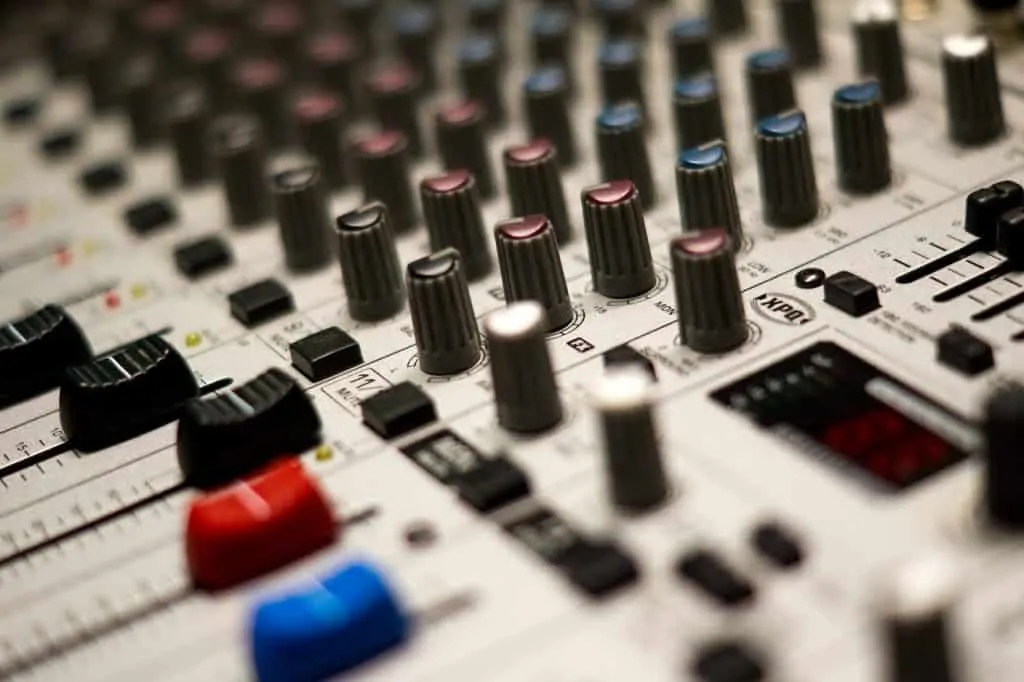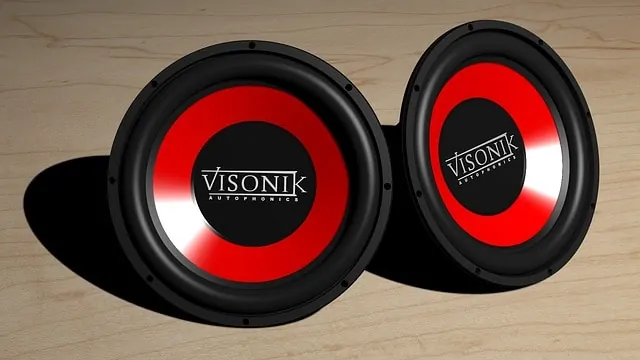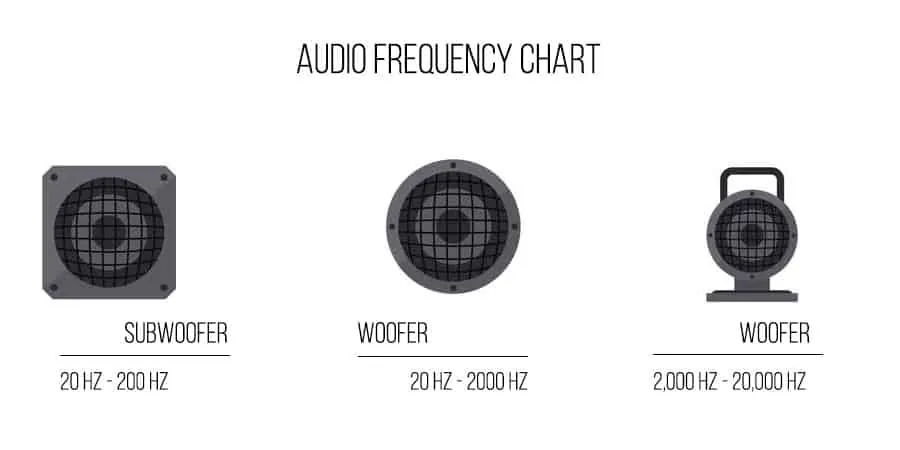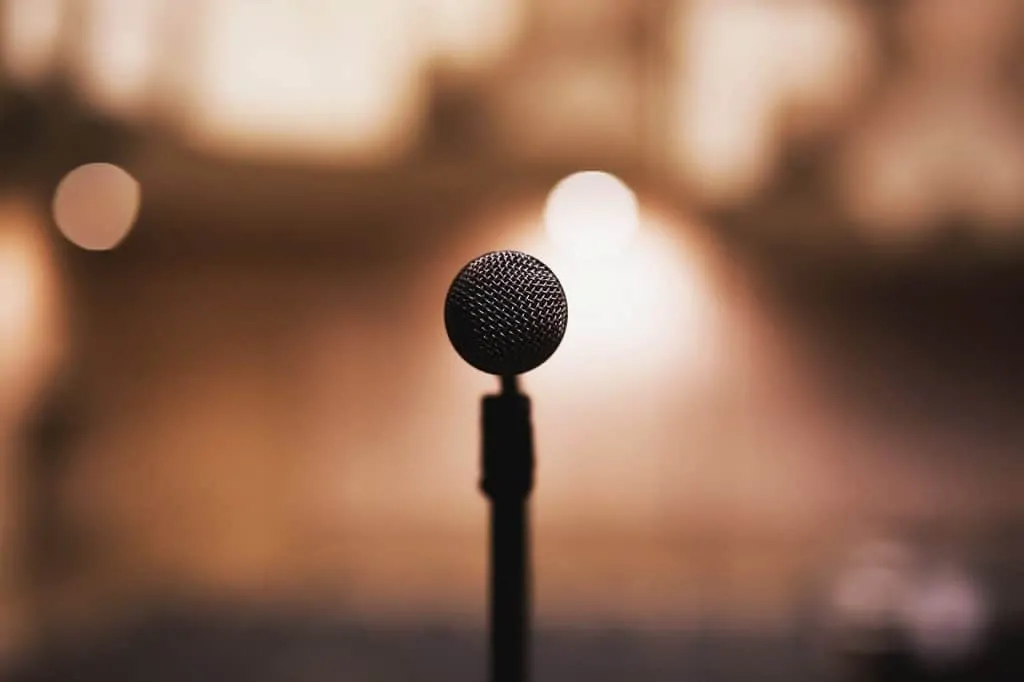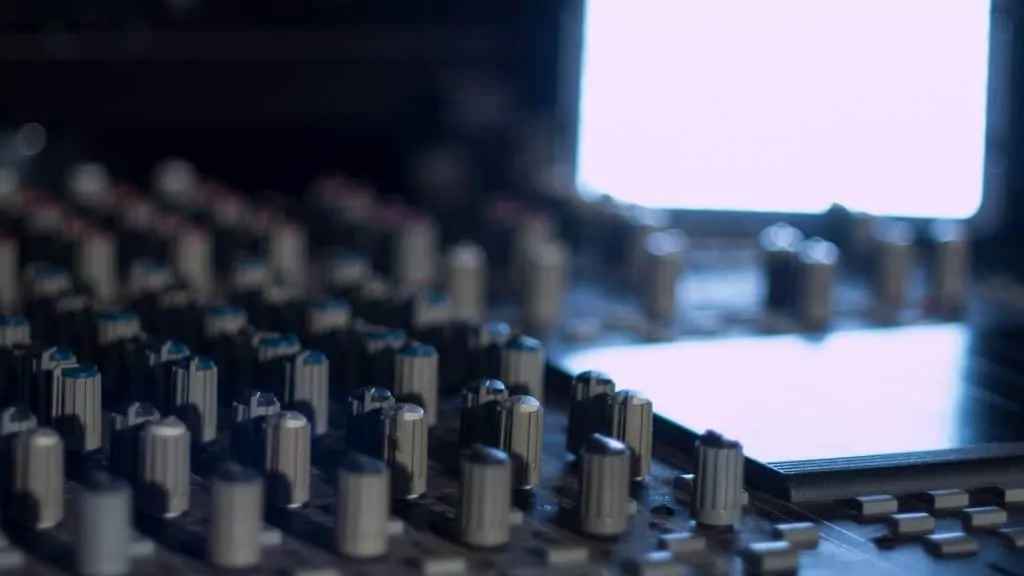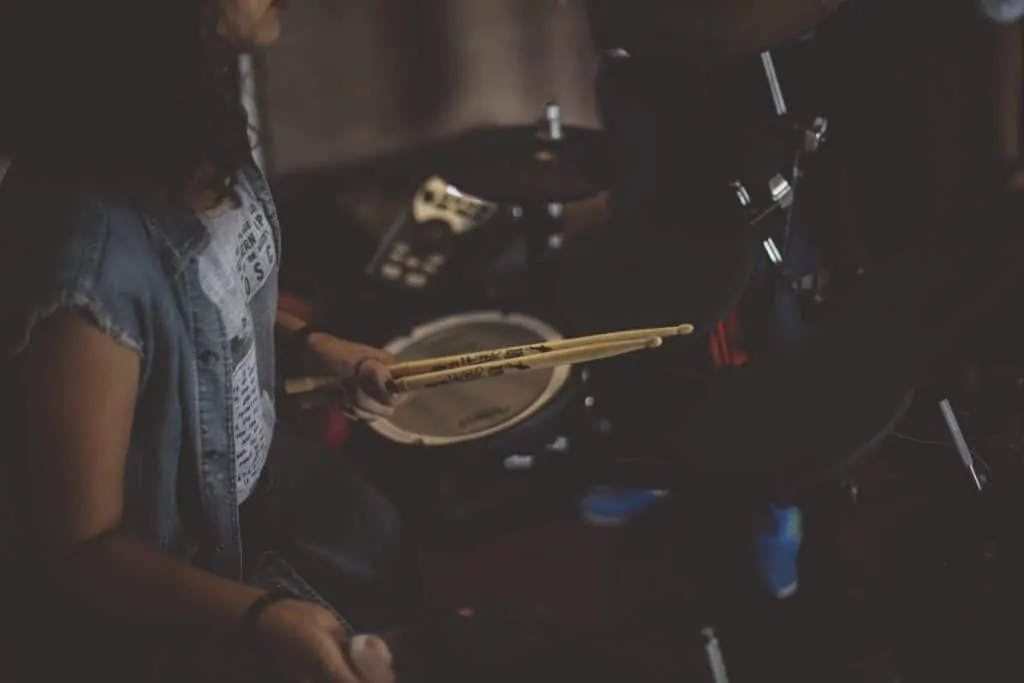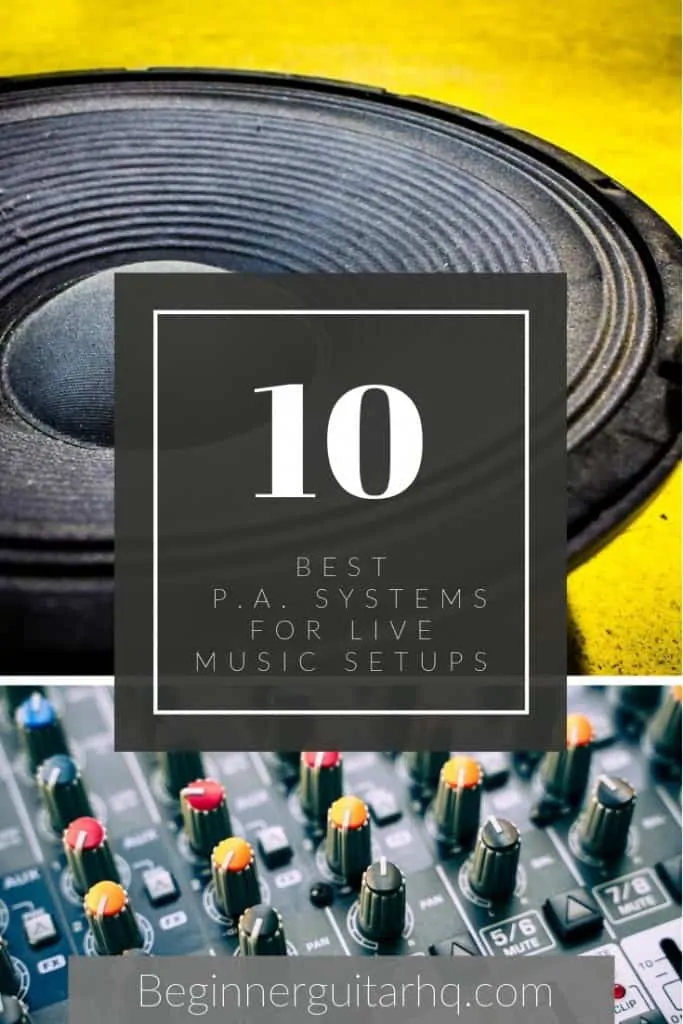How to choose your first P.A. system for live shows
P.A. stands for “public address.” In the music industry, a P.A. system is a means of projecting sound to a large crowd.
Then, a P.A. system consists of PA speakers, microphones, audio controller (mixer), cables, and stands. You can use this kind of setting for live music venues, as well as a home studio and studio settings. Aside from that, there are other applications for a P.A. system like public speaking, karaoke, conferences, auditorium classes and more.
I’m here to help you choose the gear you need to set your own portable P.A. system. Alternatively, you will learn what you need to identify the best live audio settings available for you to rent at any occasion and given any budget.
Let’s dive into it.
Contents
Following this guide, you will learn:
- What is a P.A. system?;
- Are PA systems budget?;
- What to look for in a PA system?;
- Top 10 PA systems;
- Final considerations.
Here’s a good tutorial video about P.A. systems from music site Reverb:
What is a P.A. system?
We’re looking at this from the musical industry perspective. However, let me give you a quick rundown on what a PA system is:
- A public address system that projects sound from voices, instruments, and other acoustic sources.
- It consists of microphones, mixers, amplifiers (like an electric guitar amp), and loudspeakers (tweeters, subwoofers, crossovers, and monitors).
PA systems might be portable speakers with a single mic or large mixers with various speakers and microphones. You can check this guide by Sweetwater to learn how to set up your PA system with your mixer.
Either way, let’s review it very quickly.
How the PA system works
Let’s imagine we’re talking about a band ready to play live, and it’s your band. To set up your sound, you would wire your instruments as you normally do: the bass guitar into the bass amp, the guitar into the guitar amp, and so on.
The PA system starts with the microphone, which converts the sound it picks to pressure voltage. It means it turns the magnetic force of the output into small amounts of voltage.
The microphone is picking up the sound from the instrument’s amplifiers, drums, and the singer.
Then, it sends the voltage either into a mixer for EQ and volume control. The mixer’s job is to make every instrument audible and coherent. Lastly, the mixer sends the signal into the speakers or “power amplifiers.” The resulting signal is stronger and has better quality than what the mics originally captured.
Let’s review the chart down below where I’ll showcase how to set up your PA system.
Vector de Música creado por freepik – www.freepik.es
The singer or spokesperson always sings or talks directly into the mic, and the mic goes straight to the mixer. So, for example, an audio chain for a singer would go like this: singer – mic – cable – mixer – cable – power amp (if it’s an unpowered mixer) – cable – loudspeaker – audience.
There are variations of such setup like, for example, you can connect a bass guitar to a DI box, which is a link between the bass amp and the mixer.
Other times, the microphones are connected to a preamp to enhance the incoming signal. Additionally, you can send the signal from the mixer to a power amp, and then to the loudspeaker.
And lastly, you can also add signal processing racks to the mix, which pack effects like reverb, compression, EQs, delays, and anything you can imagine to give your performance a little more drama while adding a bunch more of complexity.
Understanding the mixer or audio controller
The mixer takes the mics signal and puts it to an EQ process. Its job is to make it loud, audible, and balanced, as much as possible.
A portable PA system’s mixer will only have a few inputs. However, professional mixers will have over 10 inputs to accommodate lots of mics. And each mic goes on a particular instrument like, for example, a guitar amp, a singer, or the hi-hat.
A mixer also has controllers consistingg at least of low, middle, and high-frequency knobs to adjust the sound (EQ). Each mic input represents a channel, and each channel has its own control knobs, which includes volume and gain.
Additionally, mixers have master controls knobs, buttons or switches. These are, at least, master gain and master volume. In the master section, it may also feature a master EQ knob and volume indicators, amongst other things.
More advanced mixers have built-in effects like reverb and delay, which are very good for vocals. Professional sound engineers can mix these effects as the song goes along. More so, some mixers can recall presets, which means you can save adjustments and use them on the go.

Audio controllers mix the signal from different mics and instruments in a live audio setting.
Understanding the microphones
We’ll cover what you need to know about microphones when you’re looking to hook one up to your own PA system.
Typical live audio microphones are known as “umbrella” microphones. There are two kinds of umbrella mics: condenser and dynamic.
- Condenser microphone:
A condenser mic requires phantom power to function. Phantom power means it needs to be connected to a power source via the standard microphone cable.
Condenser microphones have three power standards:
- P48: it needs 48 V;
- P24: it needs 24 V;
- P9: it needs 12 V.
Almost every mixer has built-in phantom power. Plus, you can use their internal preamps to adjust the gain, character, and effects of the microphone’s signal.
External preamps, though, can give you a better sound quality with more unique characteristics and less hum, buzz, and noise.

Condenser mics are good for portable PA systems because they are sturdier.
- Dynamic microphone:
Dynamic mics have an overall better utility because they are multi-pattern. Multi-pattern mics can capture sound from various directions. Whereas condensers are very fragile and work best with higher frequencies, dynamic mics are sturdy enough to travel with you because they are not as prone to break as their counterparts.
Both condenser and dynamic mics can either be tubular or solid-state, just like electric guitar and bass guitar amplifiers.
In summary, tubular audio is a century-old technology that relies on empty glass tubes to amplify the sound. Tubular sound is traditionally vintage, warm, and rich, as it better manages the natural tones of whatever it amplifies than the solid-state (completely digital) counterparts.
Understanding the loudspeakers
Firstly, loudspeakers are also known as “Front of House Speakers” (FOH) because they are pointed towards the audience. On the other hand, monitors are faced towards the performers.
They can either be woofers, which reproduces low and mid-range frequencies very well (which covers the bass, the drums, the voice, and almost every musical instrument and sound effect out there); or they can be tweeters, which is a smaller alternative reproducing high-frequency audio.
More modern speakers include the mid-range speaker, which incorporates the three speakers into a single cabinet. This is called a “3-Way,” while a “2-Way” incorporates a tweeter and a woofer into a single enclosure.
Remember, though, that choosing the loudspeaker is not all about the size or the number of speakers. You could have a sub-par 3-way speaker sounding way worse than a well-chosen 2-way alternative.
If you can only afford one kind of speaker, go for the one covering the most frequency range, which is the woofer.
I must also mention the crossover, which is a special electronic circuit that assigns the correct frequency range to the different speakers in a 2-way or 3-way enclosure.
Crossovers have “frequency points,” which divides the frequency range between the different speakers.
A common 2-way crossover point is 3kHz: anything above that goes to the tweeter, while anything below goes to the woofer. A typical 3-way features a 160-200hz for the woofer’s mid-range, and then the 3kHz diving point.
There’re also subwoofers, which reproduces the lower-end frequencies and are common in recording studios and professional audio settings. Take a look at this article about studio sound if you’re in further doubt.
Lastly, speakers can either be passive or active. An active speaker features the amp within the cabinet of the speaker. A passive speaker has a completely separated amp, which is a device mounted in a rack. Connecting the passive speaker to its amp needs an additional st of ¼ speakers cable.
The maximum range of the human earing goes from 20 Hz to 20.000 Hz approx. Vectors by Vecteezy
I must also explain a speaker designed for a PA system usually comes as a speaker-amplifier (power amp) combo designed to amplify the human voice coming from a microphone, or the sound coming from any instrument amplifier.
Additionally, PA speakers may have in-built in inputs and outputs plus possible volume, tone, and EQ controls that give you the ability to create a light mix.
How to choose a PA system?
Your selection of a PA system depends on your specific needs. For example, if you’re a venue owner, you would need a stationary wattage powerhouse. However, if you’re a musician looking for on-the-go gear, you would need something light and portable.
Hence, the decision comes to power (size of the venues and audiences) vs. portability. Lucky for you, we’ve got both choices lined up down below.
So, here’s what you need:
- Speakers;
- Microphones;
- Preamps (optional);
- A mixer;
- A set of cables;
Furthermore, I have to add each PA system works best in particular situations. For example, Bose PA systems carry a technology that makes these alternatives best for acoustic music.
Are these PA systems budget?
The price depends on the size of the system, which depends on your particular needs and desires.
Basically, we’re talking about two kinds of PA systems:
- All-in-one portable loudspeakers
They are easier for people who don’t want to invest too much into the complexity of a PA system. Portable PA systems consist of a set of microphones plus the loudspeakers.
These speakers have built-in EQ (which leaves the mixer out of the equation), plus a power amp to boost the signal’s voltage.
A portable speaker is everything you need in a single unit and selling for affordable price points. They are also small units you can carry on the back of your car, set it up quick, and play.
As musical site Sweetwater explains, these all-in-one systems are great for solo performers or small acoustic shows. They integrate active speakers, effects, and signal processing into a compact design.
Overall, a portable PA system carry the loudspeakers (wich are one or two), a mixer or some form of mixing with the speakers, a mic (possibly), cables, stands (possibly), and a carry bag.
A great example of this portable PA system is the budget Fender Conference, which I greatly recommend.
However, you will miss the range of sounds larger setups can offer with their separated components.
- Complete PA systems
These are more defined rigs that include everything I’ve said before. These systems are best for larger venues that require high-definition audio. On the downside, these are heavy, big, and hard to carry rigs. You or your roadie will have a tough time.
These options carry price tags with at least three zeros (we won’t go above that).
Here’s a quick video review on some good portable PA systems:
Some brands sell you a complete PA system in a single bundle, however it’s not very common. Often, you need to build a complete-rig PA system yourself by buying the pieces separately. That’s why our list is featuring mostly portable PA systems that miss on mics and stands. Whatever you may pick, there are a few things you need to consider first.
What to look for in a PA system
As choosing the loudspeakers is the most important part of the job, let’s start by the speakers.
Speaker specs
Here’re the main specifications to check the capabilities of these pieces:
- Wattage: it indicates the volume power and clarity of the speaker. Higher numbers mean they are louder and have more headroom. Headroom means they can go up the volume lever without breaking the sound.
- Weight & size: the measure of a speaker is diameter over inches. Larger speakers result in more expansive sounds. However, there’s a correlation between weight and zie, although weight varies a little depending on the construction materials of the speaker.
- Sound quality: quality heavily depends on the price, as well as the brand. Brands like JBL, Fishman, Yamaha, Harman International, Bose, Sennheiser, Sony, and Phillips offer you the best quality you can get for the price you pay. Clarity also comes with the price, but that’s what musicians are looking for.
- Active vs. passive: an active speaker comes with a power amp, whereas passive speakers need an external power amp to work. I suggest going for active speakers as they are easier to use and very common in today’s market. A passive speaker is better for professional performers as they can enjoy the modular experience they bring, which means they can couple the speaker with the power amp of their preference, thus tweaking their sound even further.
- PA monitor speakers: your musicians always need monitors as they will be able to hear themselves and thus play better. There’s also the option of in-ear monitors, which are wireless in-ear speakers that allow the performers to hear an individualized mix. However, these are harder to use and take a longer time to set-up.
Monitor speakers face the performers so they can hear themselves during the show. Mixing boards often deliver the monitor mixes through the aux send connections.
Determining your system’s size is about knowing how big and how many loudspeakers does your show needs. The room and the amount of audience will tell you what type of speaker you need. Remember that each person from the room is absorbing sound from the speakers, so the more people attending, the more wattage you need.
The Musician’s Friend site adds there’re a lot of factors to consider when planning how many watts you need for a live venue. However, they made a simple two-point list:
- A rock band playing in a medium-sized club needs about 1,500 watts, minimum.
- A pop or jazz band playing in a medium-sized club needs about 750 watts.
If you already have a team of people behind you, I almost guarantee you’ll prefer the flexible experience of passive speakers. There are additional factors to consider when setting these systems up, like matching the amp’s IEC power rating (the watts capacity) to the speaker’s power.
Lastly, adding a subwoofer will give you a richer, more vibrant sound. If you need that extra bass power and fits your budget, add a subwoofer into the mix.
Size of the mixer
The audio controller balances, processes, and mixes the signal from microphones and instruments. Then, it sends an amplified signal to the monitors and the PA speakers.
Mixers go from 4 channels to hundreds of channels. In simple terms, a 4-to-12-channel mixer is an entry-level device, suitable for a band without too much sound requirements.
Channels accept microphones and line-level devices like signal processors, preamps, and amplifiers.
To narrow your mixer selection, you must ask yourself: “How many channels do I want and need?” As a general rule of thumb, you want to have more channels than what you think you require.
For example, a rock or pop band featuring five members (and five instruments) would need more than 12 channels:
- 1 channel for the singer;
- 1 or 2 channels for the backup singer(s);
- 1 channel for the bass amp;
- 1 channel for the guitar amp;
- 1 channel for the secondary guitar or piano/keyboards amp;
- 6 channels for the drums (two overhead mics for cymbals, one mic on each thumb, one mic for the snare, and one mic and the bass drum).
It brings you to a total of 12 channels for your rock band, although you’d want to go for a model with 16 channels so you have some room to expand and correct.
A smaller show, for example, one with a single speaker, would need the smallest mixer (a 4-channel controller).
Mixer categories
First of all, let’s learn the difference between mixer categories:
- Digital mixers: the digital mixer has a wide range of dynamic effects you can pre-program, recall, and switch with several buttons. Check the Behringer X-Air XR18 for an example.
Many digital mixers are compatible with a software plug-in that extends its tonal shaping possibilities. You could tweak the sound on the computer and carry it over to the mixer with a USB flash drive. Furthermore, modern mixers are compatible with mobile devices via certain apps.
On the downside, these mixers are harder to use and require advanced knowledge. Many of their functions are hidden beneath digital menus and status screens.
- Analog mixers: even with the advantages of digital mixers, analog counterparts are still popular because they are cheaper and easier to use. You control these devices with physical knobs, switches, and faders, so their use is much more intuitive than digital audio controllers. On the downside, analog controllers are usually bigger and heavier. Check this Soundcraft Mixer for an example.
Both analog and digital mixers transmit high-quality sound as the electronic circuits are fairly the same. In fact, sound engineers agree mic and speakers distortion and coloration is the biggest obstacle to overcome.
Speaking of mics, here’s the best recording mic for acoustic guitar which you can use as well with your PA system. Feel free to check that guide out.
In the meantime, check the video below to further attend your doubts about analog vs. digital mixers:
We also have powered and unpowered mixers. Powered mixers are lighter and easier to transport, as well as easier to set up and less expensive. Unpowered mixers, on the other hand, require extra separate and expensive power amps, while powered amps ship with on-board amplification.
The thing is unpowered mixers can give you an extra edge on your live venues because you can couple them with the power amps of your preference. It means you can further tweak the sound, however, it’s also harder to use and requires a team behind you to control the additional settings.
Furthermore, unpowered mixers are the best investment in the long run as you can upgrade it buying better and better power amps.
PA system mics
As dynamic mics are more durable than condenser mics, you’d want to go for dynamic mics always. Condenser mics are better for the studio and drum kits.
Keep in mind condenser mics for live sound require phantom power, so make sure your mixer has enough phantom power inputs. A good option is the Shure SM-57 LC or the Sennheiser E604.
For example, the budget Shure SM580 dynamic mic is a great option for the singer and instrument cabinets. It remains one of the most popular options out there with its sturdy construction and excellent quality.
To minimize feedback and noise, you’ll want a unidirectional mic (opposed to omnidirectional). Unidirectional mics have either cardioid, supercardioid, or hypercardioid pickups. Cardioid mics are your pick for live sounds because they pick up sound in a nice, directional concave which you can point towards your singer or cabinets.
Lastly, you’ll have to consider if you need either wireless or wired microphones. See, singers and speakers usually prefer wireless microphones, especially if they are not using an instrument. For everything else, choose the reliance and affordability of wired mics. Wireless mics only add further complexity.
Shure and Sennheiser are the best options regarding mics for live sound or studio recording.
Keep in mind most portable PA systems don’t ship with mics.
Cables and other essentials
Lastly, you have to carry all of the cables and essential things your PA system needs to deliver a clean sound.
In most cases, you need balanced XLR mic cables or TRS (stereo) 1/4” cables. Balanced cables reduce noise from electronic sources like lights. Newer SpeakOn cables have been replacing others because they further reduce noises and deliver a better quality sound.
You also want to go for “unbalanced” 1/4” connectors instrument cables use.
As for speaker cables, you need long cables with large conductor sizes o to carry the high current drive of the speakers.
Power amps should be as close as possible to the speakers for maximum efficiency.
You can’t switch speaker cables with instrument cables. Speaker cables are thicker and constructed differently.
You’d probably want a snake, a multichannel audio distribution array that allows you to have more inputs with fewer cables.
Check the video down below to quickly understand your PA system cables:
Lastly, your mics and speakers will need their respective stands.
In summary
These are the important factors to consider when picking a PA system:
- The amount of power you need, which depends on the audience and the size of the space you’ll be playing in;
- The portability of the system;
- The budget you’re willing to invest;
- Batteries or no batteries? PA systems with batteries are smaller but heavier, plus, they are easier to use in spaces with hard-to-access power sources.
Lastly, get to know your mixer, even before you buy it, and familiarize yourself with the effects it carries;
By now, you know everything you need to know about PA systems, so let’s dive into our selection:
Top 10 PA systems
Fender Passport PA Portable Speakers
Fender is famous for their electric guitars and bass guitar series. Leo Fender founded the American company in the ’50s and remains as one of the top musical enterprises in the industry.
This budget and portable and self-contained audio system packs all of the essentials. It will give you high-quality sound everywhere you go.
The Fender Passport delivers 175 watts of power. It’s ample enough for small and medium-sized venues.
It carries a five-channel mixer that allows you to balance small musical groups with intuitive mix lecture panels.
It’s easy to set up and carry. The whole system fits within a suitcase. You just need to flip it open and discover two full-range speakers, a powered mixer, and a set of XLR cables. Each speaker has a 2.75” tweeter and a 5.25” woofer.
The mixer features the standard knobs like master volume, a 3-band EQ, and master gain. You don’t need any technical knowledge to use it right out of the bat.
The Fender Passport PA system series offers bigger and more professional solutions than the Passport, which is the smallest of the line.
It’s good for…
- Sporting events;
- Religious or worship events;
- Meetings, seminars, and conferences;
- Educational events and auditoriums;
- Small and medium gigs at clubs, coffeehouses, parties, and similar.
- Up to 75 people.
ION Audio Tailgater (iPA77) Portable Speaker
ION Audio is a 2003 company following the ideal of excelling the audio experience. Nowadays, the company is a worldwide leader in the audio industry because of its quality products and affordable prices.
ION audio brings the iPA77 as a portable PA budget solution with 50 watts of power for customers who prefer to keep things light and easy.
The PA system packs all of the goods in a fashionable manner. More so, it features BlueTooth connectivity so you can play music from your mobile devices as far as 100 feet away. It also has an Android/iOS app to improve your control.
The system packs a cable and a dynamic microphone you can set up very quickly. The box ships with a ⅛’’’ aux port you can use yo connect a CD player. Similarly, it has a built-in radio function, so you can tune AM/FM stations wherever you go.
Additionally, it packs a USB port you can jack to your computer, USB, or tablet, and give the speakers some extra juice.
The ION Audio Tailgater is a portable audio entertainment system. However, it runs on batteries and can go for about 50 hours on a full charge.
Aside from all of this, it’s a tough box built with reinforced corners to handle all of your travels.
It’s good for…
- Karaoke;
- Small conferences, seminaries, and religious events;
- Solo performers on small venues;
- Classrooms;
- Playing music on parties;
- Similar events.
- Up to 50 people.
Behringer EUROPORT MPA40BT-PRO
Behringer has been around since 1961, and it’s known as one of the best companies in the audio industry. The company produces a wide range of audio devices- They also have an excellent US-based after-sales service.
The MPA40BT-Pro is a lightweight and ultra-compact PA system. It carries a built-in 40 watts amp and an 8” woofer with a 1” tweeter. It delivers musical and vocal clarity.
It also packs a mixing panel on the back of the EUROPORT speaker. The mixer features an intuitive design with no LEDs, no switches, and no extra buttons. It has two channels, each one with its volume control, bass, and treble knobs.
It has 2 mic/line inputs with XLR jacks and ships with a Behringer dynamic mic.
It features a BlueTooth connection plus and AUX input jack to plug in your mobile device and control it with your mobile device.
The whole set comes in a durable a water-resistant polyester bag. As it weighs only 40 lbs., it’s easy-to-carry and fast to set up.
The system runs on a built-in battery. On a full charge, it runs for 12 hours. However, you can also connect it to a power source and forget about the battery.
It’s good for…
- Public announcements;
- Classrooms and small auditoriums;
- Background music;
- Solo performers on a small venue like a coffeehouse, a library, or a restaurant;
- Townhall meetings;
- Indoor sports;
- Similar events;
- Up to 60 people.
Yamaha STAGEPASS 600I
Yamaha is an Asian company known not only for their instruments and audio devices but also for their bikes.
The company has a unique design when it comes to audio products. It has been so for 30 years, a period Yamaha has used to learn how to outperform its competitors delivering quality for the buck.
The STAGE PASS 600I portable PA solution features a single design that could take you about 1 minute to set up.
It packs 680 watts of power in two lightweight speakers. It also packs a detachable powered mixer, two speaker cables, and a power cord.
The speakers deliver great clarity and quality. Plus, its sturdy design gives you plenty of reliability. It seems big, but it’s light enough you can carry it with one hand. If you choose to, you can order the rolling case as well from Amazon to make traveling easier.
The mixer has 10 channels and, what’s best, it comes with a tutorial-of-sorts: drawings on the back panel of one of the speakers guiding you on how to connect a whole musical ensemble.
The mixer also has onboard effects including digital reverbs, a suppressor, a compressor, and a versatile EQ. Additionally, it has iPod and iPhone connectivity allowing you to control it from a mobile device. Lastly, it has a USB port you can use to charge your devices.
It’s good for…
- Band rehearsal;
- Small studio set-up or home studio set up;
- Small and medium venues at bars, outdoors, halls, parks, club, and similar;
- Medium conferences;
- Medium auditoriums;
- Sporting events;
- Similar events.
- Even when the product says it can handle a full band, I would recommend trying it out with no more than a band with 3 members.
- Up to 250 people.
Rockville RPG122K Powered Speakers
This Rockville RPG122K is a portable party box built for the road. As it is, you’ll find it suitable for many applications.
It features two 12” (woofer) speakers with a combined force of 250 watts. The primary speaker is an active speaker that has a two-channel amplifier, which means is a stereo portable PA system.
The secondary speaker is passive. It connects to the primary with a 1/4” jack speaker cable that ships with the system.
It has two mic inputs (XLR or 1/4). Additionally, there’s a stereo RCA line input for karaoke or backing tracks. Extra inputs are an SD, BlueTooth, and a USB port.
Each input has its own volume control, which means you have some room to make a little mix. Besides, there’s a master volume control, as well as master treble and bass controls.
It has a LED that allows you to control a paired BlueTooth device with play & pause buttons, skip, and volume control.
The LED screen also allows you to move around audio settings with a pre-programmed equalizer.
The Rockville RPG122K ships with the two speakers, two speaker stands, a dynamic microphone, a remote control, and the cables you need to plug it all together.
Lastly, the remote control allows you to change the EQ settings, the volume, and BlueTooth settings.
It’s good for…
- Music playback;
- Speakers;
- Small church groups;
- House parties;
- School outdoor events;
- Little league;
- Solo performers on an acoustic guitar or a piano;
- Acoustic ensembles;
- Conferences, seminars, religious, and educational events;
- Similar events.
- Up to 150 people.
- If you want to play with a band with this system, consider adding a subwoofer, as the frequency response is not low enough to enhance the low-end side of the spectrum (bass and drums).
Bose L1 Compact
Although it doesn’t specify the watts it carries, the Bose L1 Compact is ultra-lightweight, compact, and powerful.
The Bose bundle packs an L1 Compact power stand for the subwoofer, an L1 Compact loudspeaker array (which has mid and high speakers), 2 x L1 Compact Extensions, the Extensions array bag, a power stand canvas speaker cover, and a power stand cord.
The speaker has three different heights you can choose from. It has a collapsed position, which has the mid/high inside the subwoofer and stands 16.5” high. It’s the best position for small conferences, lectures, and similar situations where the audience is seated and the speaker is standing.
You can instead place one of the extensions so the speaker stands at 4ft. It’s best for small venues, conferences, classrooms, and boardrooms.
And the last position is where the speaker stands at 6.5ft. high. Its purpose is for larger audiences, bands, and DJs.
The two extensions fit in the carry case and weighs about 2.3 lbs, so they are easy to carry. The subwoofer and speaker fit together in another bag and weight 27.6 lbs. combined. The Bose L1 fits in the trunk of any car or even the back seat.
As for inputs, it has a single XLR input with volume, treble, and bass knobs. The secondary input has both 1/4” an 1/8” jacks, plus a stereo RCA input. It has a separate volume control but nothing else.
Additionally, both inputs feature Bose’s ToneMatch® technology, which optimizes the sound for acoustic guitar or voice. If you’re looking for extra inputs, search for the T8S ToneMatch digital audio mixer designed for the Bose T1.
If you use any other mixer, you will need to connect it with the stereo RCA input.
It’s good for…
- One man band;
- A duo band (but only one instrument);
- Acoustic shows;
- Corporate DJs;
- Small venues;
- Small DJ parties;
- Similar events.
- Up to 80 people.
- I don’t recommend using this set up with drums or other percussions as they will overpower the speakers. On the other hand, electronic percussions will work just fine with these speakers.
JBL EON208P Portable All-in-One 2-way PA System
JBL is a well-known brand in the audio industry. This particular PA system is an all-in-one live-sound setup solution that goes especially well with acoustic music.
The package carries a detachable 8-channel mixer with professional controls and BlueTooth audio; two speakers, a dynamic microphone, and the cables you need.
The inputs and outputs are as follows:
- ¼” / XLR (x4)
- ¼” balanced TRS (x4)
- RCA jacks (x1 pair)
- 3.5mm jack (x1)
- ¼” balanced TRS RCA jacks output(x1 pair)
- 3.5mm jack (x1) output.
Overall, the mixer laid out two mono channels plus a stereo channel. Each channel has a 2-band EQ with bass and treble knobs. Also, each channel has its own reverb and volume controls. More so, there’s an on and off switch for the reverb you can use to change the sound quickly.
However, the stereo channel (the one with a 1/4” jack and RCA inputs), there’s no EQ and no reverb knobs.
The mixer’s main control panel has a master volume control plus a stereo monitor with RCA connection.
Lastly, it also has a 1/8” aux input to plug in a mobile device and play some background music.
The PA ships with two speakers with 160 watts of power. Each speaker has a 6.5” woofer plus a 1” tweeter.
The EON line is quite large, and the EON206P is the most compact and smallest of the series.
It’s a compact and convenient setup. As for the sound, expect a warm and rich quality with great mid-range and high-frequency clarity.
It’s good for…
- One man band playing in small venues like cafes, libraries, bars, and restaurants;
- Outdoor acoustic guitar shows;
- Indoor acoustic guitar shows;
- 3-member bands rehearsal;
- Similar events.
- Up to 100 people.
Fishman SA220 Solo Performance System
This system is a single speaker delivering 220 watts of power. As Fishman commonly does, it also delivers great clarity and quality of sound.
The easy to carry and lightweight system is an array line of six custom high-excursion 4” midrange drivers plus a tweeter. It’s a unique combination you won’t find anywhere else, which offers you an ultra-wide dispersion and a deep sonic penetration. Besides, it has an enhanced bass response with its custom-designed woofers.
The speakers have two mic/instrument channels with an in-built preamp. It features a 3-band EQ, phantom power for condenser microphones, effect loops, an anti-feedback technology, and a reverb.
Plus, it has an aux input with volume level controls to plug some background music.
Lastly, it’s quite portable as it weighs only 25 lbs. and ships with a bag with wheels plus a speaker stand.
It’s good for…
- It’s specially designed for a solo singer and songwriter playing guitar, piano, or similar. Acoustic guitars and vocals are projected with extra clarity and power.
- Up to 150 people.
Peavey APP Audio Performer Pack
Peavy has been making affordable musical gear since 1965. This particular Peavy AP System is a versatile and small enclosure that ships with two loudspeakers, two speaker stands, a 4-channel mixer, two dynamic cardioid mics, and cables.
The mixer has four mono channels with XLR and 1/4” inputs. Each channel has volume, tone, and reverb adjustments, although I don’t recommend using the reverb on this device. Additionally, each channel has a 3-band EQ.
On the rear of the mixer, there’s a 1/4” speaker output and a footswitch for internal effects. If you use a footswitch you would be able to mute and unmute the reverb without touching the mixer.
Also, you can find an RCA input/output plus a 1/4” output you can use to plug a subwoofer or a monitor.
As for the sound, the APP Audio Performer delivers much more than the 50 watts of power it has on each speaker. It’s loud and powerful. Each speaker features a 10” woofer plus a 1” tweeter, so the mids and highs have great clarity, great for vocals and musical bands.
It’s good for…
- It’s perfect for keyboards, acoustic guitars, and background music;
- 3 to 4 members band playing on small and medium venues;
- Band rehearsal;
- Studio set-up;
- Small outdoor venues;
- Medium indoor venues;
- School, churches, city halls, community centers and similar situations looking for an affordable live sound set-up for their speakers;
- Mobile DJ, albeit it needs an extra subwoofer;
- Similar events.
- Up to 200 people.
Pyle PPHP1037UB Active Loudspeaker
Pyle has been building high-quality speakers since 1960. Their reputation has grown steadily in the United States. They are now known as a brand making technologically-advanced original speakers with the Pyle Driver line.
Closing up our list is the PPHP1037UB alternative from Pyle. This is an ultra-compact but powerful active loudspeaker. It’s a single-unit PA system with mono sound. If you want stereo sound, you should go for a couple of this.
It’s a loud 10” woofer speaker with a 1” tweeter. The speaker has a whopping 700 watts of power that easily projects voice and musical instruments across a whole sports field. It also has a wide frequency response, which means you don’t necessarily need a subwoofer unless you want to punch the bass up.
Overall, this speaker can reproduce the entire audio spectrum without getting drowned in large venues.
The PPHP ships with one cardioid dynamic microphone, one line-level (with RCA and XLR inputs), a 1/8 aux, USB, SD, and BlueTooth connectivity. It’s compatible with any media, so you can connect a DJ system or a mobile device for background music.
Each input has its volume control. Additionally, there’s a master volume knob plus bass and treble controls.
There’s also a LED control panel you can use to control BLueTooth functions like pause & play. The extra record feature will allow you to record what it plays directly to a USB or an SD card, and it will save it as a WAV file you can then transfer to your computer to edit.
You can also chain link multiple digital active speakers with an XLR cable from the line out port.
Although it’s heavy, it has a handle for you to carry these professional stage speakers from the concert to your home.
It’s good for…
- One man band or small bands looking to record their gigs;
- Up to 3 members band on medium and large venues;
- Outdoor musical events;
- Outdoor sporting events;
- Outdoor parties;
- School and church events;
- You can use this as side PA system for your on-stage monitors. The 15’’ version is better for the whole band.
- Up to 200 people.
As you have seen, not every PA system is good for your band or your performance. Be sure what you pick fits your requirements and remember amplifying a band with both bass and drums requires the most power and frequency range.
Why do you need a P.A. system?
I wrote this article because it’s hard to set up a P.A. system yourself, let alone choose the speakers and controller to do it.
Often, people leave this to third-party professionals, something I think damages your potential to sound great. See, every PA system is designed for specific situations, so you should know your situations, your needs, your sound, and your preference, and then choose or rent the one that will do justice to your performance.
I hope I guided you through your first or next PA system. Even though I haven’t said everything you need to know to set it up yourself, there’s plenty of extra resources on the article you can check if you’re in doubt.
Good luck!


